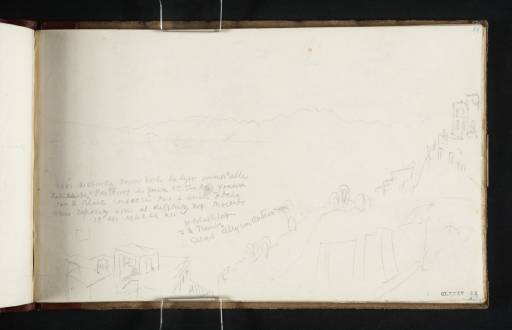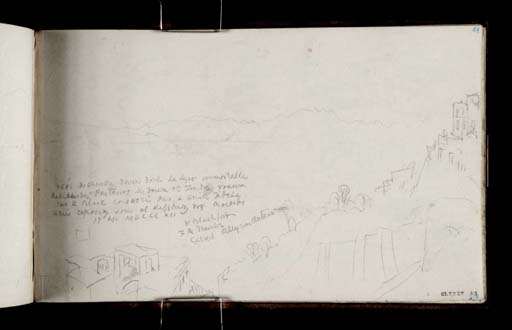Joseph Mallord William Turner Naples and Vesuvius Seen from Virgil's Tomb 1819
Image 1 of 2
Joseph Mallord William Turner,
Naples and Vesuvius Seen from Virgil's Tomb
1819
Joseph Mallord William Turner 1775–1851
Folio 71 Recto:
Naples and Vesuvius Seen from Virgil’s Tomb 1819
D15867
Turner Bequest CLXXXV 69
Turner Bequest CLXXXV 69
Pencil on white wove paper, 113 x 189 mm
Inscribed by the artist in pencil French text within left of sketch, see below
Inscribed by ?John Ruskin in blue ink ‘278’ bottom right and ‘69’ top right
Stamped in black ‘CLXXXV 69’ bottom right
Inscribed by ?John Ruskin in blue ink ‘278’ bottom right and ‘69’ top right
Stamped in black ‘CLXXXV 69’ bottom right
Accepted by the nation as part of the Turner Bequest 1856
References
1909
A.J. Finberg, A Complete Inventory of the Drawings of the Turner Bequest, London 1909, vol.I, p.549, as ‘Virgil’s tomb’.
Turner’s viewpoint for this panoramic vista across the Bay of Naples is the so-called Tomb of Virgil on the Posillipo hill, see folio 70 (D15865; Turner Bequest CLXXXV 68). During the nineteenth century it was one of the most famous prospects in the city and Turner made a number of variant drawings of it during his 1819 sojourn. The view looks east across the bay towards Vesuvius and the Sorrentine peninsula and the composition continues on the opposite sheet of the double-page spread, see folio 70 verso (D15866; Turner Bequest CLXXXV 68a). Visible on the right of this page is the steep slope of the Posillipo hill with the winding road known as the Salita di Sant’Antonio (present-day Rampe Sant’Antonio) which zig-zags from Piedigrotta towards the church of Sant’Antonio.1 A contemporaneous description of the route as it would have been experienced by Turner can be found in Revd John Chetwode Eustace’s travel guide, A Classical Tour through Italy (first published 1813):
Proceeding westward along the Chiaia and keeping toward the beach, we came to the quarter called Mergellina. To ascend the hill of Posilipo over whose sides this quarter spreads, we turned to the right, and followed a street winding as a staircase up the steep and terminating at a garden gate. Having entered, we pursued a path through a vineyard and descending a little we came to a small square building, flat-roofed, placed on a sort of a platform on the brow of a precipice on one side, and on the other sheltered by a super-incumbent rock. An aged ilex spreading from the sides of the rock, and bending over the edifice covers the roof with its ever verdant foliage. Numberless shrubs spring around, and interwoven with ivy clothe the walls, and hang in festoons over the precipice. The edifice before us was an ancient tomb – the tomb of Virgil!2
Turner made notes from this passage in the Italian Guide Book sketchbook (Tate D13955; Turner Bequest CLXXII 13).
Other sketches related to the expedition to Virgil’s tomb can be found on folios 69–69 verso, 71 verso (D15904–D15905, D15868; Turner Bequest CLXXXV 90–90a, 69a) and in the Naples; Rome C. Studies sketchbook (Tate D16102 and D16143; Turner Bequest CLXXXVII 14 and 55). Compare also a drawing by James Hakewill (1778–1843), Naples and Mount Vesuvius from above Virgil’s tomb, 1816 (British School at Rome Library), reproduced in Hakewill’s Picturesque Tour of Italy (published 1820), a book to which Turner also contributed illustrations.3
Also on this page is a French inscription which reads: ‘PRÉS du chantre divin, Dont La Lyre immortelle | Repeta des Pasteurs les doux et Tendre voeux | Sur ce Banc consacré par L amite Fidele | amis reposez vous et resserrez vos noeuds | 17 Ap. MDCCCXII [Near the divine Bard, whose immortal lyre repeated the pastors’ soft tender wishes, on this bench consecrated by faithful friendship, Friends, rest and strengthen your bonds]. Professor Sam Smiles has identified the source of the text as an inscription which could be found on a marble bench adjacent to Virgil’s tomb.4 According to contemporary guidebooks, the verses were composed by Armand Louis Charles Rose de Lostanges (also known as Le Chevalier de Lostanges, 1759–1836), a French nobleman and an officer in the French Royal Navy.5 A onetime citizen of Naples Lostanges had gained a reputation for his wide-ranging knowledge of literature, mathematics, astronomy and geography, and was also known for his collection of antiquities. The date of the inscription, 17 Ap[ril] 1812, coincides with his residence in Naples whilst he was serving in the Neapolitan navy.6
The meaning of a further transcription, ‘W Blackford | F R [?Misstez] | Gabriel Alles [?seur Autean]’ remains unidentified.
Nicola Moorby
October 2010
Revised by Nicola Moorby
June 2015
Compare an untitled drawing by James Hakewill (1778–1843) (British School at Rome Library), reproduced in Tony Cubberley and Luke Herrmann, Twilight of the Grand Tour: A catalogue of the drawings by JamesHakewill in the British School at Rome Library, Rome 1992, no.5.49, p.278. The same pathway and terrace canalso be seen in a later painting by William Parrott (1813–69), Naples from near Virgil’s Tomb, exhibited 1853(sold Christie’s, 23 November 2005, lot 193).
Tony Cubberley and Luke Herrmann, Twilight of the Grand Tour: A catalogue of the drawings by James Hakewill in the British School at Rome Library, Rome 1992, no.5.43, p.271.
How to cite
Nicola Moorby, ‘Naples and Vesuvius Seen from Virgil’s Tomb 1819 by Joseph Mallord William Turner’, catalogue entry, October 2010, revised by Nicola Moorby, June 2015, in David Blayney Brown (ed.), J.M.W. Turner: Sketchbooks, Drawings and Watercolours, Tate Research Publication, December 2012, https://www


